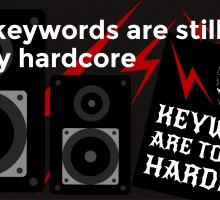When you are producing effective SEO copywriting for websites, it seems there is often a fine line between writing naturally flowing copy that will appeal to your customers, and ending up with text that is stuffed with keywords to increase your search engine rankings.
In fact this does not have to be the case. You do need to include your target keywords in your SEO copywriting, or the search engines won’t know that your web page is relevant to that particular keyword, but you don’t need to overuse it. In fact search engines value naturally flowing text as much as your visitors do, and you will be rewarded more highly by the search engines for having quality content, than for having lists of repeated keywords.
Here are some concepts you should be familiar with for successful SEO copywriting:
1. Keyword optimization
This is simply the process of including certain keywords or phrases in your copy so that the search engines realize that your web page relates to them.
2. Keyword density
This is the number of times your target keyword or phrase appears in your copy in relation to the total number of words on that page. To show that your copy is relevant to that particular keyword, without getting penalized by the search engines, you should aim for a keyword density of between 3% and 7%.
3. Keyword prominence
This refers to the placement of your keywords and phrases throughout your SEO copywriting. Search engines are more likely to pick up a keyword that is placed near the top of your web page, preferably in the first paragraph or headline, than they are further down the page. Placing your keywords in prominent positions will ensure they are recognized by the search engines.
4. Keyword proximity
When a phrase is entered into a search engine, it will look for any page that contains a combination of the individual words that make up the phrase, whether they appear in the same order or not. This means that your key phrase can still be effective even if the words are used separately, and in a different order. However the value of your key phrase with the search engines will be higher the closer together the word are.
Example: Take the key phrase ‘common SEO copywriting mistakes’
It will still be effective if it used in the following sentence:
• Typing mistakes as well as bad spelling are surprisingly common in these examples of SEO copywriting.
However, it will have more impact with the search engines if it is used as follows:
• Here are five common SEO copy writing mistakes.
5. Latent semantic indexing
This is a technology that has been used by the search engines for some time, but is increasing in value when it comes to SEO copy writing. It means that when search engine spiders pick up a particular keyword on a web page they will look for other related keywords or phrases that they expect to see there. They will give more credit to a web page that contains the other words or phrases they associate with that keyword.
What is website copy designed to do?
We are told that search engines like ‘fat’ sites, with plenty of content, which is certainly true, but filling your website with useless text won’t help your business to make sales, no matter how high your web ranking is and how many visitors you get. Website content should meet certain criteria to increase the success of your business, so ask yourself the following questions about your copy.
Is it compelling?
As an online business, you want your customers to take a particular action when they arrive at your site. Whether this is buying a product from you, ordering a service, subscribing to your newsletter, or clicking on an affiliate ad, your copy should drive them to take exactly that action. Copy that distracts your visitors from the task you want them to complete may be doing your business more harm than good.
Is it simple and easy to understand?
You know your business inside out, and you are probably familiar with all the industry jargon or abbreviations that go along with it. That doesn’t necessarily mean that your customers are though. Your SEO copywriting should use simple ad easy to understand words and phrases. Web users have a notoriously short attention span, and if they don’t understand what you say the first time, they may not bother to read it again.
Is it accurate and up to date?
Obsolete or inaccurate material is unforgivable online. Unlike published documents, which tend to go out of date soon after they are printed, web users expect the information they read on websites to be factually accurate and up to date. Leaving stale or outdated content on your website will damage your online reputation and make it seem that you don’t know what you are talking about. Make time to review and update your content as often as possible.
Does it answer all your customers’ questions?
You need to be sure that all the information your customers might require about your company or products is available right there on your site. If your customer has to visit another site to have their questions answered, you may have lost yourself a sale.
Is it suitable for your target audience?
Getting to know your customers and your target audience is crucial for effective SEO copywriting. You need to know what they really care about and what is important to them so you can focus your writing accordingly. It doesn’t matter if you write brilliantly clever and witty content; if your customers aren’t interested in it you’ve wasted your time.
Is it concise?
While you do need to cover all the information your customers might want, you also have to do it in as few words as possible. Web users tend to skim read instead of looking at every word on a page, so highlighting the crucial words, and using short sentences and bullet points can be more effective than long waffling paragraphs of text.
If your copy meets all of the above criteria, it will appeal to your customers, and help you to make those sales once visitors arrive at your site. Strategic placement of keywords and phrases, along with the use of related words, will ensure that search engines can establish the relevance of your site and index it accordingly. Balancing your copy so that it is effective both for your customers and the search engines may take some practice but it is far from impossible.



